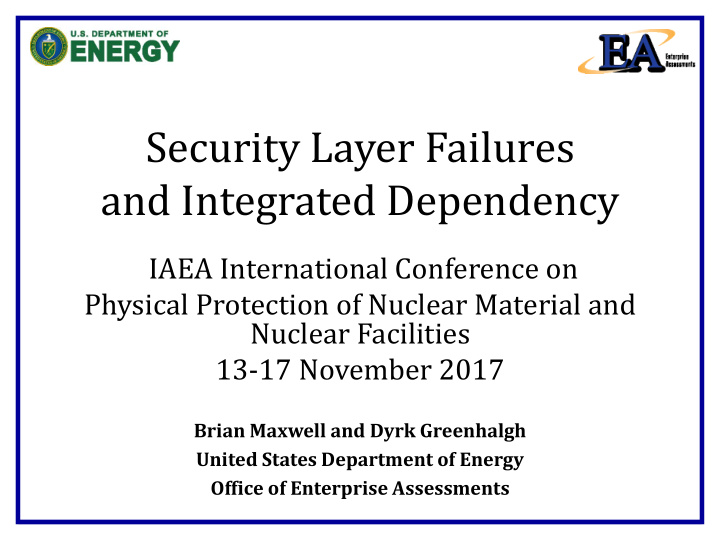



Security Layer Failures and Integrated Dependency IAEA International Conference on Physical Protection of Nuclear Material and Nuclear Facilities 13-17 November 2017 Brian Maxwell and Dyrk Greenhalgh United States Department of Energy Office of Enterprise Assessments
Presentation Outline • Enterprise Assessments introduction • Layers in security design • Single points of failure • Security component dependencies • Security system dependencies • Testing for integrated dependencies • Case study • Conclusion 2
Office of Enterprise Assessments The Mission of the U.S. Department of Energy ’ s (DOE) Office of Enterprise Assessments is to: – Report on the status of protection measures of DOE sites – Implement regulatory enforcement programs – Operate the DOE National Training Center 3
Layers in Security Design INFCIRC/225/Revision defines defense in depth as: “ the combination of multiple layers of systems and measures that have to be overcome or circumvented before physical protection is compromised. ” 4
Layers in Security Design • Layers integrate various detection and delay components, and response strategies • For example, an unauthorized attempt to penetrate a security layer would result in detection of adversary actions, delay of forward progress, and a response to interrupt the adversary • A failure of a component in one layer should not affect other layers or components 5
Single Points of Failure • Power systems • Communications infrastructure • Alarm management systems • Non-complementary sensors • Supply-chain management • Personnel 6
Component Dependencies • Identical component use throughout the system • Compensatory measures • Life-safety override of security components 7
System Dependencies • Detection, delay, and response order within a layer • Programmatic elements • Rules of engagement • Performance assurance 8
Measuring Layer Interdependency • Testing across system boundaries • Scenario determination using adverse conditions • Difficulty in creating proactive policies 9
Case Study Security Breach at Special Nuclear Materials Storage Facility • Failures in testing and maintenance program • High false alarm rates led to delay in alarm response • Complacency of protective force officers • Over reliance on inadequate compensatory measures • Misinterpretation of and adherence to existing security policy • Communications breakdown regarding ongoing facility repairs • Inadequate funding and resource allocation • Fractured management structure led to confusion of accountability and responsibility 10
Conclusion • Common failure modes contribute to adverse affects throughout the entire system • Broadening the evaluation of layer interaction is important • Integrating this information with future design and enhancements provides additional layers of resilience 11
Thank You Questions? Brian Maxwell Brian.Maxwell@hq.doe.gov United States Department of Energy Office of Enterprise Assessments 12
Recommend
More recommend